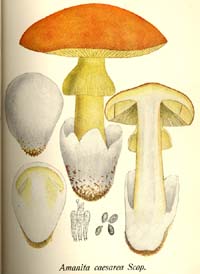 Key to Gilled Mushrooms Key
Key to Gilled Mushrooms KeyThis is a key to gilled mushrooms, that is, mushrooms having a definite cap with a fertile surface consisting of gills. The fruiting body usually also has a stem, although that may be lateral or absent (usually, then, the mushroom is growing from wood). You can use this key to identify mushrooms that you find.
 Agaricales Order
Agaricales OrderFruiting body containing fibers (usually in the stalk)
 Amanita Genus
Amanita GenusFruiting body having a combination of some of the following characteristics:
Stalk growing out of a cup of cottony tissue called a volva (all white-spored mushrooms with a volva go here)
Cap with scattered patches or flakes of the same sort of tissue as the volva (see second picture), easily peeled off
Annulus (skirt-like ring on stalk)
 Vaginatae Section
Vaginatae SectionCap margin distinctly striate in maturity
Either (most commonly) annulus absent and colors brown or grey, or
(rarely) annulus present and colors bright: red, orange or yellow
Volva sack-like in some species, in others clamped tightly to the stem, leaving traces in bands of color on the stalk
Vaginatae SubSection

Diagnosis
- Cap usually some shade of brown or gray, occasionally white
-
Annulus absent, but there may be strangulated zones on the stem
-
Universal veil material generally not present (or only occasionally) on the cap
-
Volva sac-like, or clamped tightly to the stem
Comments
This is one of the most undernamed groups of mushrooms in all of mycology. Previously undescribed species are being found all the time. You're not quite in mushroom identification purgatory here (for that, see the Omphalinoids!); it's more like one of those science fiction stories where you stumble into a valley filled with organisms that no one has ever seen before
One or two new species were officially discovered in Chicago a few years ago, and more may be coming (see Amanita SM1 and Amanita SM2). If you find one of our new things, or something that doesn't fit a description here (we've got pretty much all of the "official" species covered), please dry it and send it to me or a mycologist
Narrow down your identification:
Larger Vaginatae Stirp- Cap more than 1 1/2" across at maturity
-
Basidia mostly four-sterigmate
Small Vaginatae Stirp- Cap up to 1 1/2" across at maturity, more often around 1"
-
Basidia predominantly bisterigmate






 Key to Gilled Mushrooms Key
Key to Gilled Mushrooms Key Agaricales Order
Agaricales Order Amanita Genus
Amanita Genus Vaginatae Section
Vaginatae Section





